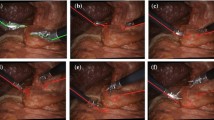Abstract
In SCARA robots, which are often used in industrial applications, all joint axes are parallel, covering three degrees of freedom in translation and one degree of freedom in rotation. Therefore, conventional approaches for the hand-eye calibration of articulated robots cannot be used for SCARA robots. In this paper, we present a new linear method that is based on dual quaternions and extends the work of Daniilid is 1999 (IJRR) for SCARA robots. To improve the accuracy, a subsequent nonlinear optimization is proposed. We address several practical implementation issues and show the effectiveness of the method by evaluating it on synthetic and real data.
Similar content being viewed by others
References
H. H. Chen, “A Screw Motion Approach to Uniqueness Analysis of Head-Eye Geometry,” in Computer Vision and Pattern Recognition, 145–151, 1991.
E.-W. Chionh, R.N. Goldman, J. R. Miller, “Using multivariate resultants to find the intersection of three quadratic surfaces,” ACM Transactions on Graphics 10 (4), 378–400 (1991).
J.C.K. Chou, M. Kamel, “Finding the position and orientation of a sensor on a robot manipulator using quaternions,” International Journal of Robotics Research 10 (3), 240–254 (1991).
K. Daniilidis, “Hand-eye calibration using dual quaternions,” International Journal of Robotics Research 18 (3), 286–298 (1999).
F. Dornaika, R. Horaud, “Simultaneous robot-world and hand-eye calibration.” IEEE Transactions on Robotics and Automation 14 (4), 617–622 (1998).
B. Drost, S. Ilic, 3D Object Detection and Localization Using Multimodal Point Pair Featurs, in International Conference on 3D Imaging, Modelling, Processing, Visualization and Transmission (3DIMPTV), 9–16 (2012).
B. Drost, M. Ulrich, N. Navab, S. Ilic, Model Globally, “Match Locally: Efficient and Robust 3D Object Recognition,” in Computer Vision and Pattern Recognition, 998–1005 (2010).
L. J. Everett, M. S. Burnett, “Experimentally Registering Position Sensors,” in IEEE International Conference on Robotics and Automation, 641–646 (1996).
S. Hinterstoisser, S. Benhimane, N. Navab, “N3M: Natural 3D Markers for Real-Time Object Detection and Pose Estimation,” in IEEE International Conference on Computer Vision, (2007) 1–7.
R. Horaud, F. Dornaika, “Hand-eye calibration,” International Journal of Robotics Research 14 (3), 195–210 (1995).
ISO 8373:1994, “Manipulating industrial robots,” Vocabulary, 1994.
ISO 9787:1999, “Manipulating industrial robots,” Coordinate systems and motion nomenclatures, 1999.
A. E. Johnson, M. Hebert, “Using spin images for eficient object recognition in cluttered 3d scenes,” IEEE Transactions on Pattern Analysis and Machine Intelligence 21 (5), 433–449 (1999).
B. Kaiser, R. A. Tauro, H. Wörn, “Extrinsic calibration of a robot mounted 3d imaging sensor,” International Journal of Intelligent Systems Technologies and Applications 5 (3/4), 374–379 (2008).
B. Kenwright, Dual-Quaternions From Classical Mechanics to Computer Graphics and Beyond, 2012. Accessed 2014-05-08, 11 pages. wwwxbdevnet/misc_demos/demos/dual_quaternions_beyond/paperpdf
S. D. Ma, “A self-calibration technique for active vision systems,” IEEE Transactions on Robotics and Automation 12 (1), 114–120 (1996).
S. Rémy, M. Dhome, J. M. Lavest, N. Daucher, “Hand-Eye Calibration,” in International Conference on Intelligent Robots and Systems, (1997) 1057–1065.
J. Richter-Gebert, Perspectives on Projective Geometry (Springer, Berlin Heidelberg, 2011).
J. Rooney, A comparison of representations of general spatial screw displacement. Environment and Planning B 5 (1), 45–88 (1978).
J. Schmidt, F. Vogt, H. Niemann, Robust Hand-Eye Calibration of an Endoscopic Surgery Robot Using Dual Quaternions, in Pattern Recognition. Lecture Notes in Computer Science (Springer, Berlin, 548–556 (2003).
C. Steger, M. Ulrich, C. Wiedemann, Machine Vision Algorithms and Applications (Wiley-VCH, Weinheim, 2007).
K. H. Strobl, G. Hirzinger, Optimal Hand-Eye Calibration, in IEEE/RSJ International Conference on Intelligent Robots and Systems, 4647–4653, 2006.
R. Y. Tsai, R. K. Lenz, A new technique for fully autonomous and efficient 3D robotics hand/eye calibration. IEEE Transactions on Robotics and Automation 5 (3), 345–358 (1989).
M. Ulrich, A. Heider, C. Steger, Hand-Eye Calibration of SCARA Robots, in 9th Open German-Russian Workshop on Pattern Recognition and Image Understanding (OGRW 2014), Electronic on-site Proceedings, ed. by D. Paulus, C. Fuchs, D. Droege, 2014.
M. Ulrich, C. Wiedemann, C. Steger, “Combining scalespace and similarity-based aspect graphs for fast 3D object recognition,” IEEE Transactions on Pattern Analysis and Machine Intelligence 34 (10), 1902–1914 (2012).
Z. Xu, X. Wang, X. Chen, J. Sun, “A robust algorithm for finding the real intersections of three quadratic surfaces,” Computer Aided Geometric Design 22 (6), 515–530 (2005).
H. Zhuang, “Hand/eye calibration for electronic assembly robots,” IEEE Transactions on Robotics and Automation 14 (4), 612–616 (1998).
H. Zhuang, Z. S. Roth, R. Sudhakar, “Simultaneous robot/world and tool/flange calibration by solving homogeneous transformation equations of the form AX = YB,” IEEE Transactions on Robotics and Automation 10 (4), 549–554 (1994).
Author information
Authors and Affiliations
Corresponding author
Additional information
The article is published in the original.
This paper uses the materials of the report submitted at the 9th Open German-Russian Workshop on Pattern Recognition and Image Understanding, held in Koblenz, December 1–5, 2014 (OGRW-9-2014).
Markus Ulrich studied Geodesy and Remote Sensing at the Technische Universität München (TUM) and received his PhD from TUM in 2003. In the same year, he joined the Research and Development department at MVTec Software GmbH as a software engineer and became manager for Research and Development in 2008 heading the Research Team. Since 2005, Markus Ulrich is also a guest lecturer at TUM, where he teaches close-range photogrammetry. Since 2013, he is a guest lecturer at Karlsruhe Institute of Technology (KIT) as well, where he teaches machine vision.
Carsten Steger studied computer science at the Technische Universität München (TUM) and received the PhD degree from TUM in 1998. In 1996, he cofounded the company MVTec Software GmbH, where he heads the Research Department. He has authored and coauthored more than 80 scientific publications in the fields of computer and machine vision, including several textbooks on machine vision. In 2011, he was appointed a TUM adjunct professor for the field of computer vision. Since 2013, he is a member of the Technical Committee of the German Association for Pattern Recognition (DAGM).
Rights and permissions
About this article
Cite this article
Ulrich, M., Steger, C. Hand-eye calibration of SCARA robots using dual quaternions. Pattern Recognit. Image Anal. 26, 231–239 (2016). https://doi.org/10.1134/S1054661816010272
Received:
Published:
Issue Date:
DOI: https://doi.org/10.1134/S1054661816010272




